by W. Cranshaw and R. Wilson* (6/13)
Quick Facts…
- Flea problems on pets are uncommon in Colorado. Fleas reproduce poorly in the low humidity of homes.
- Most flea problems originate from fox or skunks that den in the vicinity of homes.
- Vacuuming the area around where pets rest and using insecticides and traps can help manage flea problems.
- Plague is a potentially life threatening disease that is moved among wild rodent populations by fleas—primarily the rock squirrel flea.
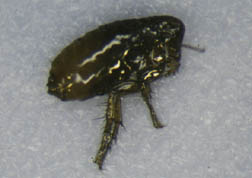 |
Figure1. The human flea, Pulex
|
Fleas are small (1/13 to 1/18 inch), dark, reddish-brown insects that feed on blood. Adults are wingless, flattened laterally and are heavily armored. These characteristics help them survive on animal hosts. The hind pair of legs is well-developed for jumping. Fleas are sometimes mistaken for other small insects that also hop, notably springtails and flea beetles (see fact sheet 5.592, Flea Beetles). Adult fleas have specialized mouthparts to suck blood.
There are approximately 80 species of fleas in Colorado, among the greatest number found in any state. However, flea problems around the home and on pets are not as common as in other parts of the United States. Colorado’s dry climate is unfavorable for flea development, particularly the immature stage. However, some types of fleas are common on wild animal hosts and in the burrows or nests of some mammals where the humidity may be high. Very few species of fleas are ever involved in bites of humans or domesticated pets.
In Colorado, the most common flea that bites humans is the human flea, Pulex irritans. Despite the name, these fleas are normally associated with wild mammals such as skunks, foxes and coyotes. Human bites occur when the dens of wild animals are abandoned and fleas scatter. These fleas may get picked up by pets or move directly into a home. The cat flea, Ctenocephalides felis is the most important flea in much of the U.S. as it can reproduce on both dogs and cats. Fortunately, it is uncommon in Colorado. However, people moving into the state from areas where fleas are common (e.g., Texas, California, Florida) can bring heavily infested pets with them. These cat fleas may become established in a home and perhaps even overwinter indoors, provided there are sites within the home where humidity is sufficiently high.
Other fleas that occasionally bite humans are associated with squirrels, ground squirrels, prairie dogs and other wild rodents. Of these, the rock squirrel flea, Diamanus montanus, is the primary species which transmits the bacteria that produces plague.
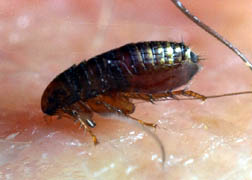 |
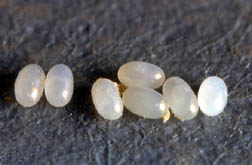 |
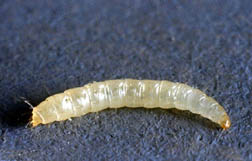 |
Figure 2. Cat flea (Ctenocephalides felis) adult feeding. (Photo from the K. Gray collection.) |
Figure 3. Cat flea (Ctenocephalides felis) eggs. (Photo from the K. Gray collection.) |
Figure 4. Cat flea (Ctenocephalides felis) larva. (Photo from the K. Gray collection.) |
Flea Bites
Flea bites to humans appear as itchy, red spots usually surrounded by a red halo. Bites often occur in clusters, particularly at edges of tightfitting clothing. Some individuals are extremely sensitive to flea bites; however, others are fairly immune and may react little. Humans are not a favored host of fleas and most bites occur when the fleas are starved from the absence of favored animal hosts. Clusters of small dark spots on bedding, the excrement produced by fleas, is one clue that fleas are present.
Life History and Habits
Flea eggs are laid around areas frequently used by animal hosts. The larvae that hatch from these eggs are rarely observed. They are worm-like and do not feed on animal blood. Instead, they consume blood-rich waste from adult fleas or other organic material around the host animal’s den. Larvae require several months to reach the adult stage. Low humidity, which is common in this region, greatly prolongs development. Pupation occurs when the full grown larvae move to small cracks and produce a cocoon covered with debris.
All fleas found in Colorado homes are associated with wild animals nesting in or around the home. When the animal leaves permanently or dies, the fleas scatter in search of new hosts. For example, the human flea is commonly associated with skunks or foxes and occurs in homes when these animals abandon their dens. The adult fleas scatter at this time and may readily get picked up by domestic animals or humans. Orchopeas howardi is a species of flea associat-ed with fox squirrels, often entering homes when carried on dogs. Related fleas are found on certain mice (Peromyscus spp.) and wood rats (Neotoma spp.).
Management of Fleas on Pets
Flea control usually involves treating domestic animals with insecticide shampoos, flea dips, flea collars, and using flea combs that physically remove the insects. Flea control measures should also include managing the egg and larval stages by washing or thoroughly vacuuming pet bedding on a regular basis. Insecticides can also be applied to carpets, cracks and crevices around areas where the pet resides. Among the more effective treatments are borax compounds and insecticides that affect flea growth, such as methoprene (PrecorR) or fenoxycarb. The drawback of these methods is that they require frequent and thorough application to disrupt the life cycle. Also, particularly with some formerly used products, there are concerns with potential side effects of treatment, such as the toxicity of lindane to cats.
Several new flea control products and applications have been developed in recent years and are described below. These use preventive strategies that interrupt reproduction and break the flea life cycle.
The Pill (Program®). This product (lufenuron) prevents flea eggs from hatching. It is administered orally to pets once a month at mealtime. Dogs are given the tablet form and cats receive a liquid suspension. Both formulations can be mixed with the pet’s food. Dosage is adjusted for the size of the animal. When a flea bites a treated animal enough of the active ingredient gets ingested to prevent flea eggs from hatching. Program® is available only by prescription through veterinarians. A companion product (Sentinel) contains both lufenuron and a heartworm medication.
Egg Stopper Collars. Unlike conventional flea collars that contain insecticides that kill adult fleas, these collars contain an insecticide (methoprene or pyriproxyfen) that interferes with normal egg production and egg hatch. Once a flea collar is placed on a pet the insect growth regulator releases from the collar and distributes over the fur of the animal. These collars can be effective for six months and can effectively break the flea life cycle. One such brand, Ovitrol/Ovitrol Plus Flea Egg Collar® is available through. Retail versions also include Fleatrol Flea Egg Collar® and Relieve Collar®. Make sure the flea collars contain as the active ingredient insect growth regulators (methoprene or pyriproxyfen), as many flea collars have other active ingredients that do not disrupt insect growth.
A drawback of the collars can be unequal distribution of the flea control product on the fur. This varies with the size of the animal and the thickness of the fur. Collars sometimes also lose effectiveness if they are repeatedly wet or become dirt encrusted.
Spot-Ons. Another effective flea treatment is to apply a topical medication between the shoulder blades of the animal. These topical applications kill adult fleas, larval fleas and eggs. They are also effective at killing ticks. Two veterinarian-supplied products are currently available—Frontline® (fipronil) and Advantage® (imidacloprid). These products kill fleas for at least one month. Frontline Top Spot® is effective for up to 3 months on dogs. Another spot-on product available through retail stores is Biospot®, which contains the insect growth regulator pyriproxifen.
The best advice for the above-mentioned flea control products is to begin treatment early in the season. Treatments that begin in spring greatly reduce the likelihood of serious flea problems developing in the summer, when flea infestations tend to be greatest. Flea control applications should kill stray fleas that animals acquire outdoors or in kennels and can prevent the need for applying other flea treatments in the home.
Other Methods to Manage Fleas
Adult fleas may also be trapped. Several traps currently on the market use colored light and heat to attract fleas. The fleas become trapped on a sticky surface. For limited infestations often found in Colorado, traps can be quite effective.
Flea infestations originating from wild animals almost always die out on their own since fleas reproduce poorly in the dry air of the home. However, flea problems can be very annoying for several weeks. Since adults are more resistant to dry conditions, using contact insecticides can relieve some of these problems.
If the location of an abandoned animal den is known, the site can be treated with insecticides to prevent fleas from migrating where pets may be more likely to acquire them. Some formulations of permethrin-containing insecticides, such as deltamethrin (e.g., DeltaDust®), have been used to treat animal dens for flea control. Treating lawn areas can also be useful if fleas have dispersed to these sites.
Plague
Plague is a potentially life-threatening disease caused by an infection of the bacterium Yersenia pestis. Even though plague rarely affects humans in Colorado (typically around one case per year), it still holds great historical importance including three major pandemics such as the devastating Black Death of the Middle Ages. Since its establishment in the United States at the turn of the century, plague has been a persistent concern in California, Arizona, Colorado and New Mexico. In the 43 year period between 1957 and 1999, there were 45 confirmed plague cases originating in Colorado, of which nine resulted in death.
Plague can infect all rodents. Cats are also very susceptible. Dogs can become infected. However dogs are more resistant to infection than most mammals and seldom exhibit signs of illness.
Transmission
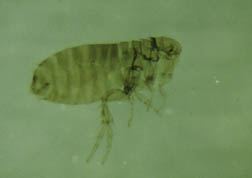 |
Figure 5. Rock squirrel flea (Diamanus (Oropsylla) montanus), primary vector of plague in Colorado. |
Among rodents, where the disease is maintained, almost all spread occurs via fleas. Not all fleas effectively transmit plague. Those that do become infective days or weeks after ingesting blood from a plague-infected rodent. In Colorado, the primary flea vector is the rock squirrel flea and the primary hosts are rock squirrels, prairie dogs, wood rats and other rodents that live in burrows or elaborate stick nests. The human flea, most commonly encountered in homes, is not involved in transmitting plague in Colorado.
Once the plague bacteria are ingested by the flea, it reproduces within the gut and may form a plug of the flea’s digestive system. Some time is required between when a flea is infected and when it is capable of transmitting the organism; for the rock squirrel flea this averages 53 days. Since the plague organism also is lethal to the flea, due to the gut obstruction, fleas often die before they can transmit the disease. However, an effect of the bacteria blocking the gut is that the infected flea becomes starved and thus more actively bites and seeks a host. Fleas capable of transmitting the disease usually do so in the course of biting; less commonly, the plague organisms are transmitted when scratching the flea feces into bites or wounds.
Symptoms
Symptoms of plague include rapid rise of temperature two to three days after exposure. This is usually accompanied by headache and general feelings of illness. As the disease progresses there is swelling and inflammation of lymph glands, most often at the base of limbs. This swelling of lymph glands, called buboes, gives rise to the term bubonic plague for the most common clinical form of the disease.
Plague also has a much rarer pneumonic form. This occurs when infectious respiratory droplets are coughed or sneezed from infected humans or animals and inhaled by a susceptible human. Pneumonic plague can also occur secondarily as a complication of inadequately treated bubonic plague. This is the means by which some historical outbreaks of plague have primarily been spread.
A recently recognized source of human infections involves contact with infected cats. Plague-infected cats are clearly ill. Most characteristic of infection are swollen lymph glands, generally under the chin and these may drain pus. Persons that are bitten or scratched by infected cats typically develop bubonic plague but those that inhale infectious material coughed by a cat can develop the more dangerous pneumonic form of the disease.
Treatment
Plague can be successfully treated given prompt diagnosis and appropriate medication (generally certain antibiotics). A physician’s immediate attention is essential if plague is suspected!
Management
Mass rodent die-off is a good indication of plague outbreak in an area. If such an event is observed it should be promptly reported to local health department authorities for confirmation and, if necessary, prevention recommendations.
If there is plague in your area, treat pets that roam outdoors for fleas. Dips are recommended for this purpose. Flea collars are not recommended for this purpose as they may not be sufficiently reliable for prevention of plague. Various medications fed to pets are also available through veterinarians. Monitor the pet closely for symptoms of plague development. If any suspicious symptoms are detected, take the animal promptly to a veterinarian.
Pets that have brought home infective fleas that have been exposed to plague-infected rodents, their burrows or nests may survive several weeks. Therefore it is often a good idea to quarantine the pet to a restricted area for a few weeks if possible exposure is expected. For further management, this restricted area should be treated for fleas as well, using products effective against adult fleas, such as various pyrethroids (e.g., permethrin, deltamethrin) and carbaryl (Sevin), as labeled.
*W. Cranshaw Colorado State University Extension entomology specialist, and professor, bioagricultural sciences and pest management; and R. Wilson, DVM, research scientist, department of microbiology, immunology and pathology. 4/04. Revised 6/13.
Colorado State University, U.S. Department of Agriculture, and Colorado counties cooperating. Extension programs are available to all without discrimination. No endorsement of products mentioned is intended nor is criticism implied of products not mentioned.
Go to top of this page.





